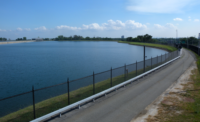A major new infrastructure program to reduce or treat raw sewage flowing into Cleveland-area waterways and Lake Erie will move forward, as a result of a Clean Water Act settlement between the U.S. government and the Northeast Ohio Regional Sewer District (NEORSD) announced Dec. 22. The program includes the construction of seven new tunnels and at least $42 million in green infrastructure projects.
The program builds on a growing consensus among the Environmental Protection Agency and green development advocates that green infrastructure can be an effective tool to help reduce stormwater overflows. Some typical green infrastructure components include the construction of wetlands, bioswales, retention ponds and other "green" solutions to manage rainfall before it even makes its way into the sewer.
According to the Justice Dept., NEORSD discharges nearly 5 billion gal of untreated, raw sewage approximately 3,000 to 4,000 times per year into Lake Erie and nearby rivers.
The settlement requires NEORSD to spend approximately $3 billion over the next 25 years to install pollution controls, including the construction of seven tunnel systems ranging from two to five miles, that will reduce the discharges of untreated, raw sewage to approximately 537 million gal per year.
Julius Ciaccia, executive director of NEORSD, says that the sewer district has already taken steps to reducing the amount of raw sewage discharging into the environment, from 9 billion gallons in the early 1970s to 4.5 billions gal now. "This plan will complement the District�s past work while helping us to comply with the Clean Water Act."
Late this fall, NEORSD awarded a $198 million contract to the joint venture team of Westlake, Ohio-based McNally Tunelling and Omaha, Neb.-based Kiewit Corporation to build the first of the seven tunnels. The project is expected to begin some time in March 2011.
Each tunnel will be bid out separately, says Kellie Rotunno, director of engineering and construction at NEORSD.
The tunnels will increase the amount of stormwater that can be stored during wet weather events, so that the sewer district's wastewater and combined sewer overflow treatment facilities, which currently use a bypass system, can increase the amount of wastewater that can be treated, Rotunno says.
The settlement also stipulates that the sewer district invest at least $42 million in green infrastructure projects to capture an additional 44 million gal of wet-weather flow beyond what the tunnels and other traditional infrastructure improvements will capture.
"Overall, we are really hopeful that the green infrastructure will provide �an environmental benefit [beyond] just controlling CSO's" for the benefit of local waterways in Northeast Ohio and Lake Erie, Rotunno says. She adds that green infrastructure is more cost-effective than gray tunneling, and may provide an economic benefit to ratepayers as well.
Ignacia Moreno, assistant attorney general for the Environmental and Natural Resource Division of the Dept. of Justice, says, "This settlement, which incorporates green infrastructure, major combined sewer overflow control measures, increases in treatment plant capacity and the possibility of transforming vacant brownfields located in minority and low income residential areas into valuable community assets�will be a model for the future."
The settlement also requires the District to pay a penalty of $1.2 million, which will be distributed evenly between the United States and the State of Ohio.
The settlement, filed with the U.S. District Court for the Northern District of Ohio, is subject to a 30-day public comment period and final court approval.



Post a comment to this article
Report Abusive Comment